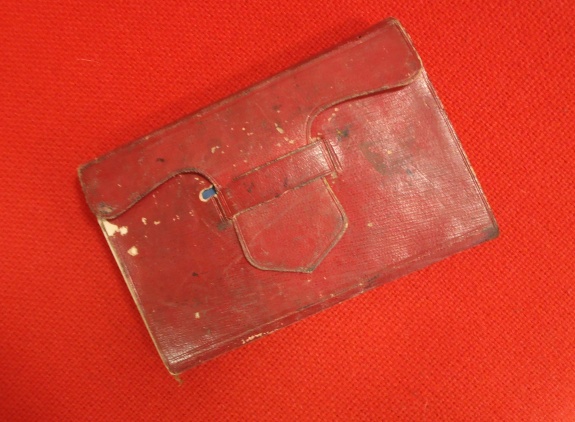
THE DIARY OF JOHN JAMES, TRENEWYDD, LLANWNDA, PEMBROKESHIRE
FOR THE YEAR OF 1846

Introduction
Inputting the diary of a farmer, John James, Pencaer Abergwaun for the single year of 1846 was the project, with the original material being kindly provided by Hedydd Hughes. The information had been scanned, and while this enabled enlargement of the script (which was sometimes difficult to read), it also meant that the ‘personal’ touch was missing.
351 records were put on the Llen Natur Tywyddiadur database – and the missing 14 are the result of there being no record of environmental interest rather than a lack of entry. The farmer was obviously a very spiritual person with biblical references making up more than half of the material in the diary. Although interesting, especially where they link to the author’s daily work, these have not been inputted.
There was some uncertainty as to the name of the author of the diary and the location of where he was farming – but by using census returns for Pembrokeshire (as well as references from the diary) it has been possible to pinpoint the farm – to Trenewydd, OS sheet 157, GR SM 913 396. In English Pencaer is Strumble Head and Abergwaun is Fishguard
Hedydd Hughes, who is currently holding the diary, thought it may be that of John James and this appears to be the case.
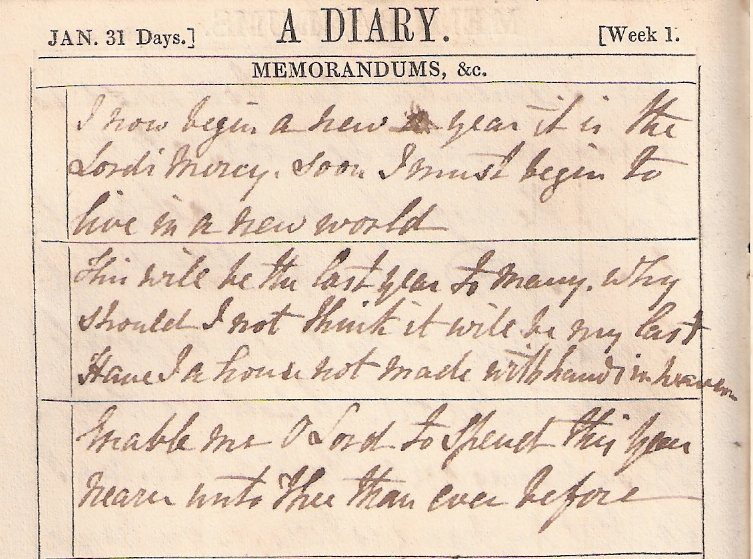
I now begin a new year it is the Lords Mercy. soon I must begin to live in a new world This will be the last year to many. why should I not think it will be my last Have I a house not made with hands in heaven Enable me O Lord to spend this year nearer unto thee than ever before
A sketch map showing part of Pembrokeshire with the sites mentioned in the text
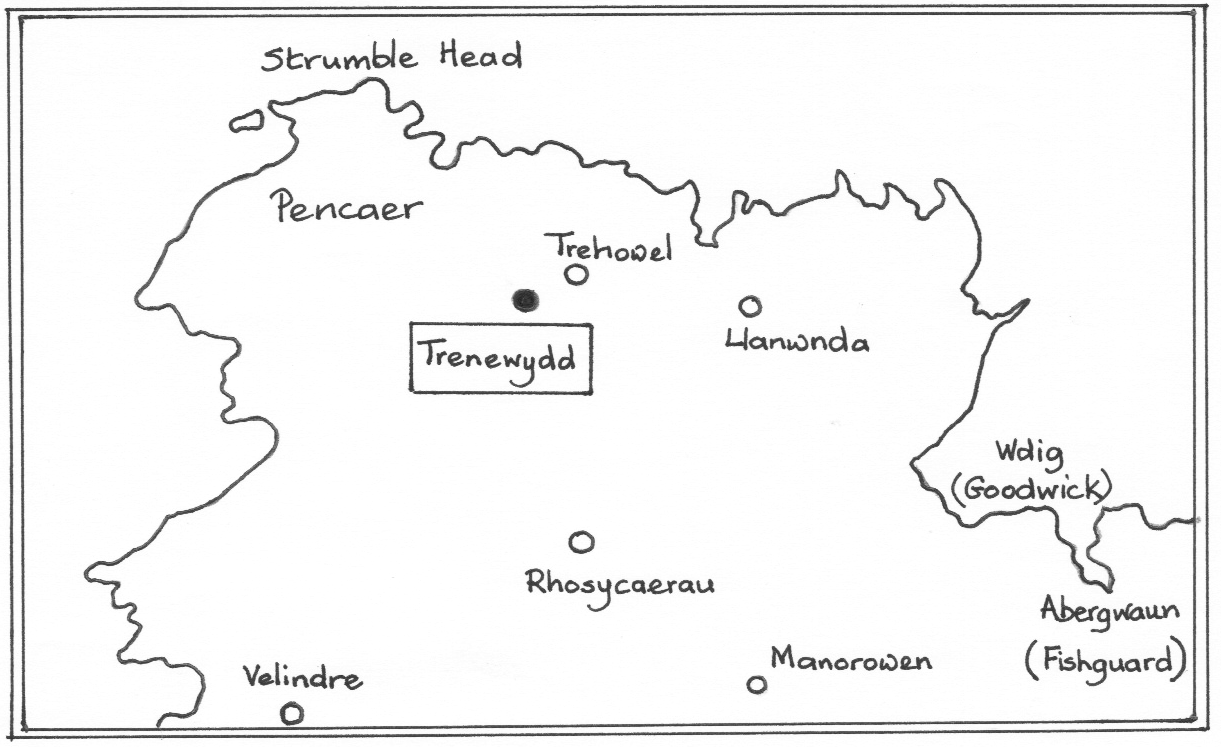
A short account of Trenewydd and the James family during the nineteenth century
In February 1797 the “last invasion of Britain” took place when a French force landed at Carregwasted Point less than 2 kilometres from Trenewydd, landing a significant number of well armed troops. They swiftly marched to Trehowel where the French leader, William Tate, set up his headquarters. Their immediate neighbours in Trenewydd were similarly occupied and ransacked for provisions and accommodation for the invaders. While the
invasion was short lived it must have been quite a shock for the families in this, the Llanwnda parish, of Pembrokeshire. William James owned Trenewydd in 1819 (Land Tax Assessments) but was not recorded as being the owner/occupier until 1823 (LTA) so the family did not experience the invasion first hand.
John James was born in 1814. His father William James, and mother Dorothy, lived in Trenewydd from about 1822 - the lease on the property having been surrendered in July of that year. By the 1841 census they farmed the estate with the help of six servants and John, then aged 27, was the only member of their family at home. William died on the 2nd February 1845 aged 85, Dorothy on December 15th 1844, aged 72.

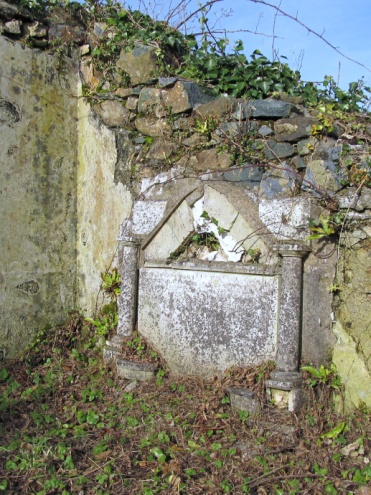
The photographs above show the plaque recording the deaths of William and Dorothy in Salem Chapel, before it was partially demolished in the 1960’s – and as it is today, propped up against the wall of the chapel remains. Further information about the chapel and John James’s part in its history follow at the end of this account.
In 1846 therefore, John, aged 32, has lost both his parents and is unmarried, taking on the full responsibility for the farm. This explains why, in his diary, John does not make much mention of family other than an aunt in Fishguard and the visits of cousins.
By 1851 John is recorded as the head of the household – a farmer of 200 acres employing 6 labourers. There are a total of 9 husbandry servants living at Trenewydd. In 1847 he married Jane (nee Williams). She was born at Velindre Farm in about 1811. They have two children - Mary D aged 1 and William just 3 months. A third child, David, was born in 1853 but died in 1860. He is buried with his parents in Salem Graveyard.
In 1861 John is described as a farmer of 180 acres, employing 4 labourers and 2 boys. There is a dairy maid, a barn maid, a house maid and a kitchen maid living in the house as well as the stable boy and the errand boy. A governess (from London) has been employed presumably to educate the children.
1871 records the farm as being 150 acres. John, Jane and William live and work there with seven servants – all aged under thirty. John’s daughter, Mary Dorothy, has married a clergyman and has, as Mary Johns, moved to live and rear a large family in the Anglican Vicarage in Manorowen, about 8 miles from Trenewydd towards Fishguard.
By 1881 the farm has been split. John continues to farm 100 acres employing 2 men and 2 boys while son William has taken over 58 acres with the help of one man. There are three female domestic servants, and two indoor male servants.
John has retired by the April 1891 census and William has taken over the whole farm. There are four domestic servants (including Margaret Lewis who has now been with the family for at least twenty years) and one male general farm servant.
According to their gravestone outside the entrance to Salem Chapel, John James JP died on December 3rd 1891 aged 78 and his wife, Jane, died December 29th 1891, aged 80.
The grave of John James, his wife Jane and son David

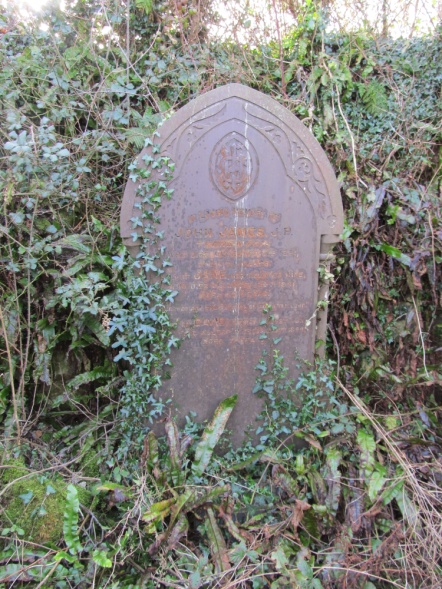
John left Mary Dorothy Johns (his daughter and wife of the Reverend Thomas Johns, clerk) and William Williams surgeon, effects valued at £3855-4s-7d. (Resworn April 1895 at £4058–4s-2d.) Jane also left effects worth £871-16s-9d to Mary. John’s cousin, John Vincent (master mariner) died on the 30th December 1891 and left £737 3s 11d, again to Mary. In total this was a very significant amount of money*. These deaths, all within a month of each other can probably be attributed to the influenza pandemic which started in 1889/1890 and continued through 1891 with several severe recurrences over the following decade.
*The possible value of this legacy can be found on MeasuringWorth.com and is quite startling. The total (£5667 4s 2d) would be worth the following equivalents in 2011:
Purchasing Power £506,200.00
Economic Status £3,544,000.00
Economic Power £5,917,000.00
According to the online catalogue of papers held at the Record Office in Haverfordwest, Pembrokeshire, the Johns family then owned and ran Trenewydd through the first decades of the twentieth century. The papers were deposited by the solicitors Johns and Pepper, Fishguard.
Vincent James Griffiths Johns, born 1872, was the eldest of John and Jane James’ 14 grandchildren and by 1901 had founded a solicitor’s firm in Fishguard, VJG Johns. He died in 1946. His brother Herbert David was also part of the practice. It is the papers deposited by this company (Johns and Pepper) that provide the ownership details for the Trenewydd estate. Herbert David Johns MC born 1887, died 31 July 1963, address - Trenewydd
In 1901and 1911 Trenewydd was being farmed by Richard Lewis and his family as the tenants – the farm being owned by Mary Johns. William James (1851) is possibly living in a boarding house in Fishguard, unmarried and described as a retired farmer. He has not yet been traced in the 1911 census, assuming he was still alive.
Language
Evidence of the James’ family language preference is limited.
Language used was not recorded until the 1891 census when John, Jane and son William are all noted as speaking both – i.e. English and Welsh. Throughout the census records 1841 – 1881 the family are recorded as being born in Llanwnda, Pembrokeshire as would be expected but in 1891 they are quite clearly stating that they were born in England. This could be an enumerator error but is unlikely –possibly they had chosen to be recorded thus. Their daughter Mary Dorothy (and her husband the Rev Thomas Johns) also spoke both languages but significantly their many children spoke only English. The 1861 census records that Rosamund Russell (?) from the City of London was employed as a governess for Mary Dorothy and William, and coming from England, she was unlikely to be teaching them in anything other than English. The gravestone inscriptions for John and Jane in 1891 are entirely in English. The family, therefore, appear to have chosen English as their first tongue by 1891. Their status in the community (for example John is a JP and owner of a number of properties) may have played a part in this decision.
~~~~~~~~~~~~~~~~~~~~~~~~~~~~~~~~~~~~~
Placing the Trenewydd weather records into the broader perspective
‘Weather and Climate’ by J Kington (Harper Collins 2010) provides a variety of weather reports for 1846 from places throughout the British Isles. Comparing John James’ records with those from Kington’s collection may provide an interesting view on the Pencaer diary.
In general Kington states that 1846 was a warm year with a very mild winter. He also notes that the period 1846 to 1850 was one of volcanic activity with a number of eruptions taking place worldwide.
The effect of volcanic dust entering the atmosphere is to reduce the light reaching the surface of the earth and reduce the surface temperature. Hekla, in Southern Iceland, erupted intermittently between September 1845 and October 1846. Ash from this eruption reached the Faroes, Shetland and Orkney. Similarly in Fonualei Tonga, a major eruption started on the 11th June 1846 which spread ash around the world for at least a year again affecting Scotland. The summer of 1846 however was described at the time as being ‘The notably hot summer’* and the harvest was reported to have been at least ‘three weeks earlier than average’** Both these comments suggest that the dust veil did not affect the south of the UK in the single year of 1846.
*Orlando Whistlecraft 1851 Rural Gleanings : Or facts worth knowing as recorded from many years natural observation in the eastern counties. (Thwaite Suffolk).
** Monmouthshire Merlin 8 August 1846.
(With thanks to Cerys Hughes – unpublished research paper)
An analysis of the diary details from month to month
January 1846
Weather summary:
The start of the year was ‘changeable’ becoming wetter and mild/damp/foggy. It turns dry and cold on the 11th and 12th then improves to a fine (‘unusually fine’) spell of four days in the middle of the month. From the 17th it is then generally wet and unsettled again. Out of the 30 records 12 refer to wet conditions, 11 to dry with changeable, foggy, mild days for the remainder. Only 3 days are noted to be cold.
This compares well with Kington’s statement of a mild winter. His January record of ‘floods’ is not specific and was likely to have been localised, so is not relevant here at Trenewydd. It was, however, ‘unusually wet’ (25th) and ‘very wet’ (19th, 23rd and 26th). Pencaer is not prone to episodes of flooding.
Farming Matters
Late December 1845 and early January 1846 John was ‘driving Backs’. Later in the diary he refers to driving stones on several occasions meaning, perhaps, clearing stones from the fields? Backs is twice spelt with a definite capital so is possibly a place name referring to a part of the farm.
On the 5th John ‘spent the morn about the garden’ with J Mathew ‘assisting’. He also records that ploughing the fallow was started on the 26th and 28th of the month. He went to Llanwnwr on the evening of the 26th re valuation of stock etc at Trenewydd although no further detail was clear.
Other entries
On the 1st day of the year John pays W Samlys for work measuring and mapping Llanwnda and Trenewyd [sic]. This may have been related to the 1845 tithe mapping of the area.
Unfortuately the field details of the crops are lost.
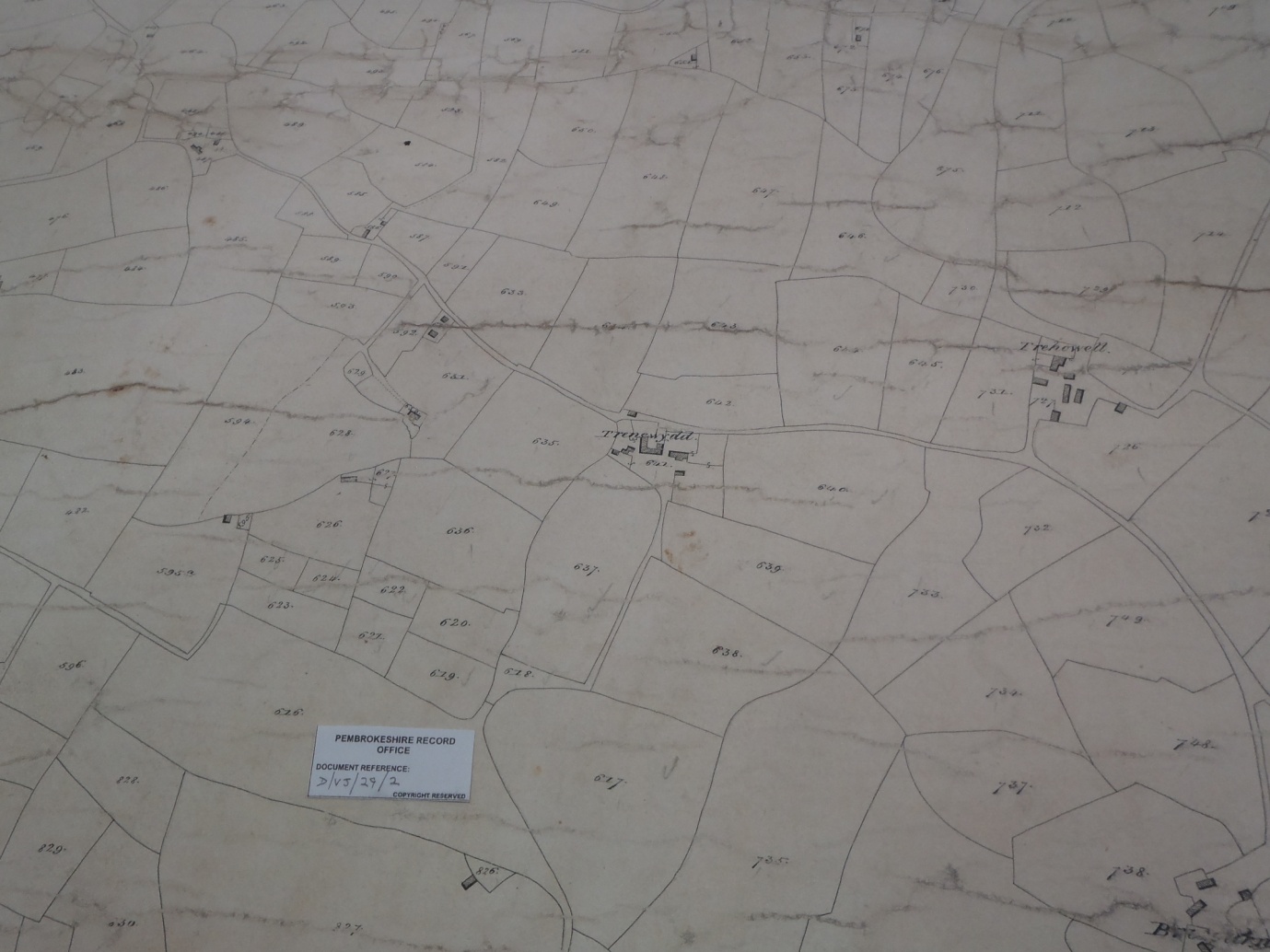
The month continues with a party at High Stiles on the 5th – with the account for this being paid on the 22nd. On the 6th he kept the ‘old Xmas day’. The ‘fidlers’ [sic] came to Trenewydd and received 1/6 (one shilling and sixpence) for their playing. On the 8th he pays his tithe dues. The ‘first pig’ was killed on the 12th – possibly in readiness for the celebration to come on the following day. On the 13th John James records ‘that Old Sallarn [sic] was kept.’ From the 18th to the 29th John was ‘not well’
The 13th of January was (and still is) a very special day in Cwm Gwaun – the part of Pembrokeshire between lower Fishguard and the Preseli mountains. The celebration of Hen Galan (the ‘old New Year’) follows the tradition of the pre 1752 Julian calendar rather than the current Gregorian calendar. The children walked/walk around the valley singing traditional songs to spread health and happiness and welcome in the New Year. They are rewarded with gifts (“calennig”) of sweets and money. Trenewydd lies about six miles over the hill to the NW of Cwm Gwaun. It implies that the festival was celebrated over a wider area in 1846 than perhaps it is today. In 2013 tractors were used to get through the snowdrifts unlike 1846 which was mild and rainy!
February 1846
Weather summary
Although there were some light showers initially the first three weeks of February were dry/fair and very fine with some frost from the 9th to the 12th. On the 21st it was changing and generally became wet with storms for the rest of the month.
Of the 26 weather records, 20 record dry, if cold, conditions and 6 are wet/stormy.
Kington notes that there was some light snowfall on the 9th and this correlates well with ‘some frost’ from the 9th to the 12th at Trenewydd. His late February mild spell was not recorded as mild by John James but it was ‘stormy’.

Farming matters
On the 2nd of Feb, a dry but not settled day, John was ‘busy at ?Cay land with oats’ – and more clearly he was ploughing fallow for oats on 10th and 11th – during a frosty period. He mentions wheat twice –on the 16th ‘went to Fishguard about wheat’ and on the 17th sending ‘60 st?ikes to Goodwick at 5/4.’ On the 5th of February 5 pigs were sold at £1-14 each at Fishguard fair but the market was ‘poor’ on the 18th. The bull went to Penlan on the 9th possibly to be sold or slaughtered because on the 15th John ‘went with Wili to Trebith??is to buy a Bull’. On the 28th he mentions that his mare is ill. (She subsequently died on the 7th March). On this day too four calves arrived.
Other entries
On the 2nd the Rev. R? came to Trenewydd with W.L (W Lloyd) for income tax. On the 10th the diary writer ‘paid this month to W Davies &c the legacy of £100 which my father left to Salem’. This is an important piece of evidence in linking the writer (John James) with Salem Chapel which was recorded elsewhere as being financed by the James family. The tailors arrived at the farm on the 23rd and left on the 25th presumably having made new clothes for the family and servants. On the 21st John went to make a garden rake at the Smiths. A Baptist preacher came to the house and John gave him 2/6 ‘to get rid of him’!
March 1846
Weather summary
The storms from the last week in February continued for the first few days in March but by the 5th it improved to showers and then became ‘very fine’. This led to a spell of dry and cold weather which continued until the 16th. Snow, frost and very cold weather followed until the 21st when it became wet and showery again. By the 23rd John is writing...’weather very showry [sic] ...ground very wet not fit for any farm work’... The month finished with 5 days of dry and fine weather. In total there were 26 weather reports of which 9 days are wet or showery, 3 are snowy and the remainder are dry/fine.
Kington states that there was a mild wet and very early spring. There is no specific entry for March. The records from Trenewydd do not generally support this where much of the month is recorded as cold and dry.
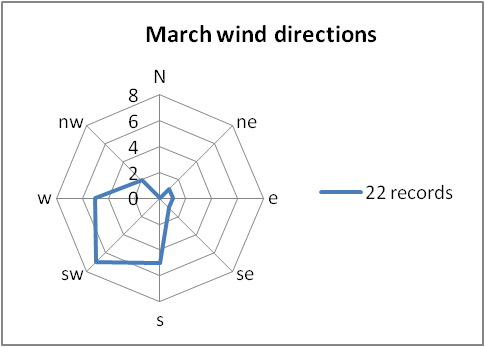
Farming matters
In spite of the showery weather John ploughed the ‘Oat Land’ and by the 6th with ‘improved, not so wet’ he was ‘harrowing the barley land.’ The oats were being sown throughout the month – over 7 days were taken up with this probably reflecting the wet weather. On the 9th, during the dry spell, John started on the early potatoes and the following day ‘Job’ was employed to set the early potatoes for a few days. John was also ‘looking after people laying foundation hedge on the way up to the rock’. The hedge appears to have been completed by the 25th. On the 28th he sowed white oats and on the 30th black oats.
Black oats and short black oats (Avena Strigosa – bristle oats) are traditional hardy oat varieties that were widely grown on marginal and upland areas throughout the UK (and Europe.) They were particularly useful for their ability to stand up well against high winds in poorer soils. Grown mainly as a fodder crop with a high protein content, the grain and straw were particularly valued as feed for working horses. White oats (Avena sativa) are those that are still in production today.
By the 21st century black oats grown as a crop were only present on the Outer Hebrides, the Fair Isles, Shetlands and in two locations in Wales – for further details of these see http://archive.bsbi.org.uk/WBull55.pdf
Other entries
On the 11th March John went up to Cardigan by coach at a cost of 4/6. He was visiting his cousin Henry J Vincent, the vicar of St Dogmels [sic]. He returned on the 13th with another cousin, Mary, this time at a cost of 3/6. On the 26th John walked into Fishguard and bought ‘10 cask for butter at 1/6’.
April 1846
Weather summary
The first week of April was wet and stormy but it changed on the 7th for several days to become dry and cold. By the 11th it was wet again becoming showery until the 17th and then dry or dampish if cold until a milder dryer few days at the end of the month. The northerly winds occurred during the dryer periods (6th – 9th and 21st – 27th) of the month.
Of the 27 weather records 11 days were wet or showery, plus 3 with snow, and 13 dry or ‘dampish’.
Kington notes that the 4th of April brought northerly winds, snow and hailstorms. It was stormy with northerly winds at Trenewydd on the 5th and the North winds continued but with dry conditions on 6th and 7th.
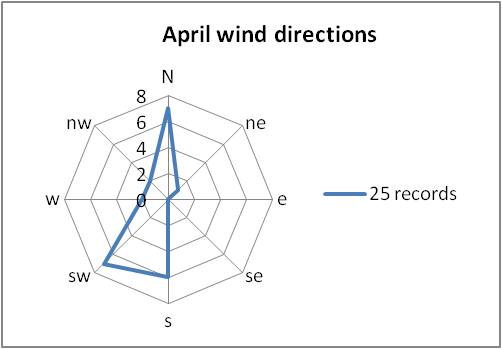
Farming matters
A milder afternoon allowed barley to be sown on the 3rd of the month but by 6th John wrote ‘it is a bad season for barley’. He continued to sow the barley on drier days for another 4 days in the month. The Fishguard Easter Fair took place on the 13th April. John sold 8 pigs at 12/6d each – significantly less than the February fair. On the 26th the cows were ‘put in’. This date coincides with the end of the late month Northerly winds so possibly implies that the cows were ‘put in’ to the fields i.e. unshedded?
Other entries
On the 6th a voting paper has been left for John James to elect a guardian. This indicates his position in the community at this time as a rate payer who was obliged to elect a representative to the Board of Guardians. The following day John’s vote was collected and he reveals that he voted for Mr Williams.
The ratepayers were obliged to elect a Board of Guardians to supervise the workhouse, to collect the poor rates and to report to the Central Poor Law Commission. This was as a result of the Poor Law Reform Act of 1834 which stated that no able bodied person was to receive help from the authorities except in a workhouse. The conditions in the Workhouse were deliberately harsh to discourage applicants. The Haverfordwest Union workhouse was built 1837 – 39 at a cost of £4000 and was paid for by the local community through the poor rate.
Later in the month (29th) he attends a meeting at ‘a vestry at Lanwnda [sic] at 10 about new value for the poor Rate many attended.’
The poor rate was set each Easter at a Vestry meeting and was for a certain number of shillings/pence in the pound with the amount a person paid based on the value of their owned or leased property. If a parish needed more money to support its poor, it increased the number of times per year that the poor rate was collected. John attended the second meeting of the year on the 28th October.
Between 1838 and 1843 Pembrokeshire had also been at the forefront of the Rebecca Riots when the tenant farmers of the area rose up in protest against the tolls that were imposed on them to use the roads. During the riots, men disguised as women attacked the tollgates. They called themselves Rebecca and her daughters most probably after a passage in the bible where Rebecca speaks of the need to ’possess the gates of those who hate them’ (Genesis XXIV verse 60). By 1843 some of the discontent had spilled over into the surrounding counties and the workhouse in Carmarthen had been attacked. The struggle of the poor farmers and farm workers was added to by the system of tithes which had changed from payment in kind to money in 1836. Payment was made to the Anglican Church whereas many of the local West Wales population were non conformist.
The workhouse was widely viewed as a harsh and inhumane system but John James makes no comment on it. This is not to say that the local community were unsympathetic to those in need – for example in the 1851 census a 14 year old ‘begging vagrant’ was given shelter at Trehowel by David and Mary Mortimer, fellow members of the chapel at Salem and John James’s closest neighbours.
Further details from http://www.nationalarchives.gov.uk/education/lesson48.htm
It is also interesting to find John James being a member of the Haverfordwest Board of Guardians in, for example, 1872, when he is reported contributing to decisions being made as to the running of the Workhouse.
Welsh Newspapers Online - The Pembrokeshire Herald and General Advertiser – Llyfrgell Genedlaethol Cymru
May 1846
Weather summary
The first 10 days of the month were mainly fine and dry. On the 10th the wind rose so that by the 11th, when John was due to leave Fishguard for Cardiff, the ship was unable to leave port. The winds remained high and from the East until the 15th. His week’s visit in the Cardiff area (15th – 23rd) was showery and unsettled at first but became drier and fine becoming ‘very fine’ while he was in Bristol (23rd – 26th). It continued to be very fine until his return home on the 28th and remained ‘very hot’ until the end of the month.
The very warm dry summer of 1846 as recorded in Kington’s work is also shown in the Trenewydd diary although John James was in Cardiff / Bristol as it started. As he returned home on the 28th it was ‘very hot’.
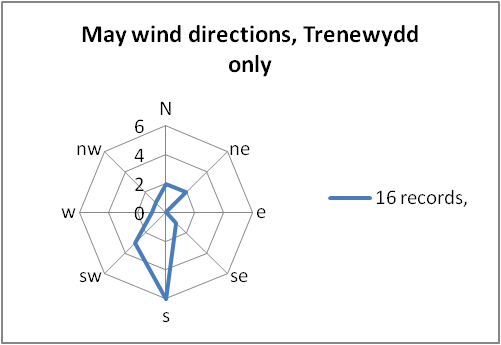
Farming matters
On the 1st May John noted that he had finished sowing all the seeds except for the potatoes. He continued to work on the ‘drawing potato dung’ (manuring and planting?) until he left Trenewydd on the 11th. He was ‘allering’ (?) wheat stacks on the 2nd. He sold J Lamb (a shopkeeper in Fishguard?) wheat at 5/10. He also cut his hair.
Other entries
As indicated above John James sailed, with his cousin John Vincent, up to Cardiff on the 13th having been delayed in Fishguard, for a day, by the strong winds.
John James notes that the wind was N.E. until they ‘got to Helwek (?)’, then was ‘right against us.’ They reached Nash Sound on the 14th with again the ‘wind right against’. Nash Point marks the entry to the Bristol Channel so winds from the NE would have made progress very slow. The sea was ‘very troubled at Anchor tonight near Cardiff’. It must have been a relief to arrive in Cardiff on the 15th. On the 18th the cousins walked into Llandaff where John James bought a new coat. On the 19th he went to see the ‘Merthyr Works by the railroad’ and slept at Dowlais ‘a very dirty place’. They remained in Cardiff until the 23rd when the ‘Margaret John’ sailed on to Bristol where he stayed at the Gloster [sic] Hotel. John James finally left Bristol on the 26th on the ‘Star’ packet (a steamship) and arrived back at Milford by 10 the same evening. The westerly winds of the 26th had had far less effect on the powered ship making for a much speedier journey home! He got back to Haverfordwest by midday on the 27th and finally to Fishguard, by coach, on the 28th and home where he ‘found all well’.
His cousin John Vincent (b 1805) started his career in the Merchant Navy as an apprentice in 1820. He progressed then to become a seaman, mate and finally in 1830 a master of a ‘coasting’ sailing ship. In 1839 he became master of the “Margaret John” a 128 ton vessel registered in Cork and sailing the Mediterranean. John Vincent’s Board of Trade Master’s Certificate of Service was issued from the Custom House in Fishguard in 1851. His service on the Margaret John was noted as being to the ‘present time’ i.e. 1850). This means that John James’s journey up the Bristol Channel was on the Margaret John.
(UK and Ireland, Masters and Mates Certificates, 1850-1927 Record for John Vincent. No 48,121. Ancestry.co.uk)
June 1846
Weather summary
June continued the hot dry spell that had started in May with the first 8 days being dry and hot or very hot. On the 9th and 10th it was ‘moist weather’ with ‘light showers’. It then returned to the dry and hot conditions until the 21st when it became ’like thunder’ although there was no rain until noon on the 22nd when there was ‘very heavy rain and thunder’ which was ‘very acceptable’. The remainder of the month was generally windy with heavy rain/showers. Of the 26 records 9 days had rain, mostly heavy, and the remainder were dry and hot.
June is recorded by Kington as being very warm, one of the warmest on record, with an anticyclonic southwesterly. By the 24th there were heavy thunderstorms. His details are taken from the SE of England (Suffolk and London) but are broadly similar to those noted by JJ in SW Wales.
Farming matters
John went to the Fishguard Whit Monday Fair on June 1st and paid £8 - 4 for a cow and calf. He spent 3 days at the beginning of the month ploughing fallow. On the 27th he went to Newport fair and ‘bought 3 cows to feed’. He recorded that Trehowel had the ‘seed hay in’ on the 17th.’
It was a busy month about the farm as well, with the saddler visiting for a day (19th). Ben Thomas was employed ‘driving stones to (the) Carthouse’ at £1 a week and John records that he was working with Ben Thomas ‘about the stones’ on the 23rd. The kiln was lit at Goodwick on the 17th and they ‘began to get the lime home’ also on the 23rd. On the 30th John went to Velindre to ‘ask about the mill’. Whether he called to see his future wife Jane (who was living with her sisters at the farm next door to the mill) is not recorded. He continued ‘breaking stones’ on the 31st.
Other matters
From the 8th to the 13th of June Ja? Evan was ‘here painting’. This may have been inside the house since the exterior is stone.
Trenewydd farmhouse dates from the early 19th century, with an earlier core, and was built of rubble stone with a slate pitched roof and stone end stacks. It is therefore possible that John James, born 1814, was part of the first family to live in the house that can be seen today. The outbuildings (probably including the carthouse) are grouped to the west of the house.
To the NE is the walled kitchen garden. The garden is shown on the 1907 25 inch OS map of the area. A nearby farm (Court) was sold in 1874/5 to a Rev Thomas Gwynne Mortimer and he is said to have brought back fig cuttings from the Holyland [sic]) and planted them in the walled gardens at Court and Trenewydd where they thrived’ (from A Pembrokeshire Squarson, by Francis Jones, Pembrokeshire History 1974)
The fig was still flourishing in 1984 according to the Western Morning Mail making an interesting record of longevity and survival!
Trenewydd Farmhouse
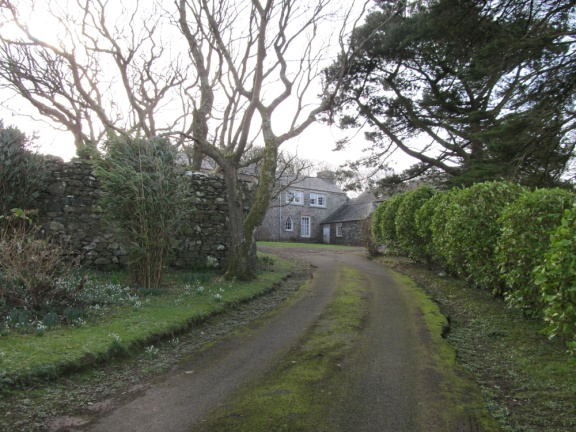
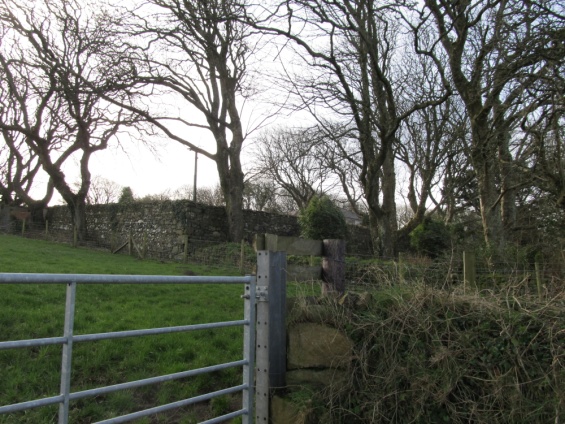
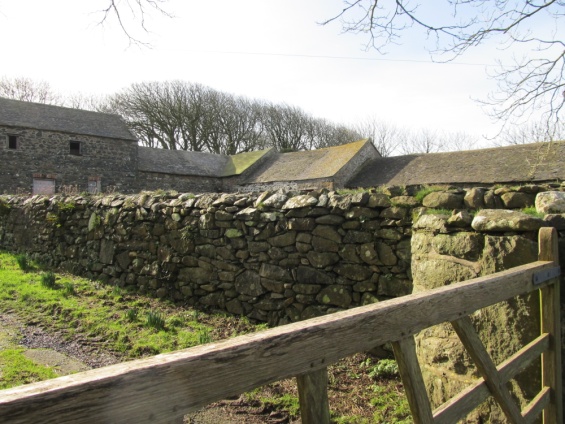
The Walled Garden The Outbuildings
July 1846
Weather Summary
The unsettled weather continued from June into July until the 9th being ‘rather wet’, ‘not warm,’ ‘wet all day’ and so on. It then turned dry for the next 12 days enabling a lot of farm work to be achieved. The rest of the month was changeable - often dry but with showers at some time during the day and very variable winds. He records a ’thunderstorm at noon & heavy rain’ on the 29th, the 30th was ‘very wet all day’ and the ‘wind everywhere. ’The 31st had a ’dry morn’ with ’showers lightening &c at noon’. A stormy end to the month!
There were 28 weather records with 7 being wet, 8 being dry and the remainder mixed.
Kington says only that July was very warm. For August, however, he starts with ‘floods in Wales’ before moving on to the hailstorms which caused significant damage in parts of England. Further comparison and information is noted in the August comments.
Farming matters
On the 1st July John (and his workers) were ‘beginning to build (the) carthouse’ and the following day the liming was finished. (Possibly 5/6 days work since the lime had reached the farm on the 23rd of June.) On the 4th he was preparing to mow the hay ‘on Monday’ and this was finished on the 7th. On the 5th the wheels of the Market Cart were ‘banded’ – had iron put onto the wheels to help protect the wood. Sadly it is not clear if this was at a local smithy or actually on the farm. The hay was ‘out’ on the 9th and by the 14th they were ‘having the hay in today in good order’. On the 17th John was about home but notes that ‘Trehowel mowing hay’ and he continues to note the progress there with ‘people at hay’ on the 20th. ‘People were also ‘driving stones to Carthouse’ on the 24th. On the 28th ‘Mr Mortimer had his hay in.’ Mr Mortimer was farming at Trehowel in 1841 and 1851. He died in 1860.
Other entries
On the 10th John went to Fishguard. He acknowledged a receipt of £40 from L Evans ‘Ints+’. The meaning of this is unclear but he occasionally used a + symbol when referring to chapel business. On the 20th he was repairing ‘Miss Fisher’s house’ in Fishguard. On the 27th and 30th he was at home with W Lloyd, a visitor perhaps?
August 1846
Weather summary
The entries for most of August show short spells of dry/wet/fine/showery weather changing every few days - best summed up as variable. This pattern, however, included a very wet spell. It started being ‘very wet at noon’ on the 17th followed by a ‘very great rain’ on the 18th when the harvest was ‘quite stopped’. The 19th and 20th were ‘very wet’. Although ‘dry’ on the 20th and 21st John was still writing on the 22nd that he was ‘doing nothing at the harvest’ implying that the late summer rains had caused problems? The last week in the month became ‘very fine’ and dry.
August in Kington’s record shows a very stormy month, starting with severe damage from hailstones and lightning strikes in the SE of England, followed by extreme flooding later in the NE of England. Flash flooding in the W of England and then damaging hailstorms in Surrey on the 15th August ‘ended the spell of summer storms’.
This does not compare with the Pencaer entries where the rains were heaviest and affected the farm most between the 17th and 20th of the month. Initially Kington also mentions ‘floods in Wales’ with no further detail but flooding was severe in Ceredigion after severe thunderstorms between 30th July and 2nd of August. The downpours resulted in loss of life, made many homeless and washed away bridges on the rivers between Aberaeron and Llanrhystud.
(Cerys Jones PhD case study. Institute of Geography and Earth Sciences, Aberystwyth University, Ceredigion, Wales)
The winds in August fall into 2 discrete sets. The winds from the N and NE blew only from the 22nd to the 29th August inclusive while those from the S and SW blew from the 5th to the 19th inclusive. A number of records were variable – (e.g. S and SW) or absent but the variation between ‘N’ and ‘S’ is clear and consistent.
Farming matters
On the 5th of August John went to ?? fair and sold a fat cow for £12-12 and bought a filly for £12 -10. On the 7th and 8th, both dry days, he was ‘about home at stones’ either clearing them from the fields or gathering them for building purposes perhaps. On the 11th they ‘began Harvest’ and the following day they were ‘at barley’. On the 18th ‘very great rain’ stopped the harvest. The following day was wet and by the 20th he was ‘at ropes for stacks’ and although it was dry on the 21st he noted the corn was not ripe at Trehowel and ‘nothing done here’. Similarly on the 22nd but by the 24th they had ‘cut and bound a little barley. A very fine spell allowed them to be ‘busy at wheat’ and 4 days later they had ‘finished with wheat’. On the 29th they ‘cut neck (see 3rd Sept.) and were binding barley’.
Other entries
On the 3rd John and W.D. Lloyd (his visitor) went ‘to Dockyard to buy some timber bought about £6 worth’. He returned in the eve to Haverfordwest and came home the following day which suggests the ‘Dockyard’ was Haverfordwest rather than Fishguard, (see 2nd and 17th Sept.)
September 1846
Weather summary
Other than one wet morning (8th) the first three weeks of September were fine and dry – with 2 days being also ‘sultry’. On the 22nd heavy rain started in the afternoon and it continued wet or showery until the last day of the month which was dry. The 29 weather records show 9 days with precipitation with the remainder being fine
Kington only records that the very warm dry spell lasted from late May until c 22nd September – which matches with the Trenewydd records well.
Farming matters
September was a busy month. On the 1st John killed 3 partridges. Whether this was for sport, food or sale is not clear. The upcoming ‘neck’ feast may well have been the reason. The 2nd they were binding and the carts went to Haverfordwest for the Dockyard timber. On the 3rd he was ‘about home binding finished binding and had the neck feast’
Neck - The last few heads of corn cut in harvest and hung up in the kitchen roof with great ceremony and allowed to remain there until next harvest. As soon as these ears were cut the reapers shouted “The neck I The neck I” and one of them had to convey it neatly bound up into the house unseen. If he contrived to get it into the house the reapers could demand a special supper that night called the neck feast and the man who carried the neck in got in addition a jug of ale with a silver coin at the bottom; if the maid servants who would be on the look out could catch this man and throw water over him there would be no neck feast and the carrier would not get his beer. A Pagan custom connected with the worship of Ceres.
(From ‘The history of Haverfordwest with that of some Pembrokeshire parishes’ by John Brown and added to by J.W. Phillips & Fred J Warren. Published by subscription 1914)
On the 4th they ’began leading in wheat’, on the 7th ‘leading oats’ and on the 9th and 10th were ‘busy leading in corn and thatching’. By the 11th they had finished ‘leading in (gathering?) everything’ and were still ’thatching’ (on the hayricks?). On the 12th the ‘horses were dreping (?) fallow for wheat. ‘Others’ were ‘busy malching (?). On the 14th they continued ‘thatching Haggard’.
Haggard is the word used in Pembrokeshire dialect to denote the enclosed space near the farmhouse where hayricks are usually erected. Usually the stacks of corn are built within it also.
(B.E. Howells National Library of Wales journal 1955)
The local Pembrokeshire word in Welsh is yr yglan – or ‘ryglan. Elsewhere in Wales it would be cadlas.
On the 17th the carts went to Haverfordwest for more timber. On the 21st and 22nd they were ‘driving earth for wheat etc’ (ploughing?). In spite of the much wetter weather they continued ‘driving earth’ on the 24th – 26th until they finished on the 28th. As the weather became wetter 3 days were also taken up ‘driving stones’, one load for the ‘Carthouse’, one for ‘Arches’ (?) and the third was cleaning stones away from about Salem.
Other matters
On two separate occasions through the month John reported he was ‘not well’. He went to a thanksgiving meeting at Caire (Rhosycaerau - Welsh Independent Chapel)) on the 14th
and on the 18th to Harmony (Baptist Chapel), also for thanksgiving. On the 21st he was visited by W. Harries of ? ilton (Milton?) ‘about exchanging lands with Sevi Lloyd. did not settle a great miser.’
October 1846
Weather summary
October was an unsettled month most days being ‘very showery’, ‘very wet’ or ‘very stormy’. From the 16th to the 18th it was ‘more dry and calm’ but this was followed on the 21st and 22nd by storms which resulted in ‘a great loss of vessels and lives at Fishguard.’(See October - other matters.) The month ended with 2/3 days of dry fine weather although the ground was ‘wet’. There are 30 records of which 8 show it was dry – the remainder (22) have rain at some time during the day.
On the 20th and 21st October Kington states that there was a ‘severe storm’ with a deep Atlantic depression (below 970mb, possibly an ex tropical hurricane) which moved east over the British Isles with severe southwest to westerly gales affecting SW Ireland, SW England and the channel coasts. Pencaer being in the extreme SW of Wales would probably have had the same weather pattern. He also notes 23rd – 24th October had storms, severe coastal gales and many shipwrecks. John James stated that the 24th was fine in the morn, with winds from the south, turning stormy at noon with heavy rain and winds from the north.
These dates match well with Trenewydd although John records the winds as being north westerly on the morn of the 20th, then swinging to the south but moving north west again on the 21st and 22nd. The stormy wind on the 24th came from the north.
Farming matters
October was another busy month. On the 17th, a rare fine day, John was ‘busy at digging potatoes’. He went to Fishguard on the 19th and remarked that ‘Lamb is waiting to sow wheat’ and notes that he himself had ‘not sown any wheat’ on the 20th. By the 24th he had ‘began sowing wheat’ but again on the 25th it was ‘can’t sow wheat’. Wheat was sown, however, on the last two days of the month even though the ground was wet.
He went to Fishguard hiring fair on the 8th and ‘engaged B Thomas... at £6 – 6. The following day (9th) was the ‘Fishguard pig fair pigs very low could not sell one’. On the 10th he ‘went to Mathry fair with a fat cow’ but ‘did not sell’ although he bought a colt for £6 – 11. The pig fair at Mathry on the 12th was ‘very low’ and finally to the fair at Newport on the 16th where he bought a colt for £11 – 10.
On the 3rd John records that ‘today we have a Cargo of Culm flour out at Goodwick E’.
Goodwick at the time was a small port immediately to the W of Fishguard – which in 1846 had been chosen by the South Wales railway company to be its major port for Ireland. This did not happen because the effects of the Potato Famine in Ireland delayed the plan. Goodwick is today the Stena Line port for Rosslare.
Culm, a mixture of anthracite dust and chippings, was layered with lime stones in the lime kiln and the whole was burnt to produce the agricultural lime that was spread on the fields to improve the soil. The need to move lime from the ports to the farms along the turnpikes and payment of tolls to do this was an initial cause for the Rebecca Riots.
On the 22nd January John had ‘paid Col Owen £17 – 6 – 6 for Culm’ probably for an 1845 order but this gives an indication of the cost of the 1846 delivery.
Other entries
On the 6th, 7th and 8th John was ‘not very well’. This in itself is not unexpected but on the 6th he says ‘not very well owing to potatoes’ Given that potato blight and the subsequent famine in Ireland (and Scotland) started about 1845 and had arrived in Wales* in that year is it possible that John knew of it and interpreted it as being something wrong with the potato itself rather than the crop failure that caused the famine?
* The potato blight that led to the famine in Ireland and Scotland was noted in Wales in 1845, (in Swansea regarding protection offered by smoke from the copper works), but John James makes no direct reference to it.
(From The Untold History of the Potato by John Reader, 2009 p206)
The storms of the 21st and 22nd widely affected the west coasts of Britain and John records these events – on the 21st ‘Very stormy 19 vessels at Goodwick in distress’ and the following day – ‘Very stormy Great loss of vessels and lives at Fishguard Wind N.W. Losses everywhere.’
........On
the morning of the 21st
October 1846, about five o’clock the Margaret, of Beaumaris, after
vainly buffeting with the storm, got on shore under Penmaen-y-for
point, in Fishguard bay. The crew, consisting of a master, a mate,
and one seaman, sought a temporary security in the rigging; in this
awful position the dreadful agony of despair gave energy to their
calls for help - nor were these unheeded. Margaret Llewellyn, of the
lower town, Fishguard, having heard their cries above the howling of
the storm, soon espied their dreadful situation. Assisted by her
sister Martha Llewellyn, William Griffiths and Thomas Phillips, they
procured a rope, and with this attached to their bodies, they boldly
faced the white crested breakers, towering as high as any which ever
washed the Fern Island, and succeeded in bringing these three
apparently doomed individuals safe to shore. Both Margaret and Martha
Llewellyn were awarded the R.N.L.I. silver medal together with one
sovereign each, whilst Griffiths and Phillips each received a reward
of 10 shillings. The Royal Humane Society awarded its bronze medal to
each of the sisters, together with a reward of £3 to Margaret and £2
to Martha.....
(From catalogue details of medal auction 1998)
The gale of October 22nd, 1846, caused no less than twenty vessels to be blown ashore at one spot (Fishguard) and all either wrecked or seriously damaged.
(From HC Deb (House of Commons debate) 12 February 1856 vol 140 cc668-77 – Hansard)
November 1846
November continued with the October dry spell but turned ‘wet’ on the 3rd until the 8th. Dry weather followed until the 15th. From the 16th to the 26th inclusive the wind is recorded as coming from the South and the weather is ‘wet’ or ‘very wet’. On the 20th he notes ‘quite a hurricane’ and also that the 22nd was very stormy and wet. By the 28th the wind had swung to the North with a ‘heavy fall of snow’ which persisted with ‘very severe frost’ and ‘snow all over the ground’ until the 31st which had very deep snow – and was ‘still snowing!’
There were 30 records in total, 9 days were dry, 17 days were wet and the last 4 days of the month had heavy snow and frost.
The final comment from ‘Climate and Weather’ for 1846 notes that the 20th of November had ‘storms, severe coastal gales and many shipwrecks. John records that the 20th was indeed ‘very wet and quite a hurricane’ and also that the 22nd was ‘very stormy and wet’. This matches well with the Kington’s entry
Farming matters
November has few records of work on the farm. Wheat was sown on the 2nd and from the 9th – 13th in the drier weather and was finished Saturday (14th.) He went to Fishguard fair on the 17th but says nothing about it.
Other entries
On the 12th John went to Fishguard and dined at his aunts*. On the 14th he ‘spent day sporting about’ probably hunting. (See Sept 1st and Dec 14th). He went to Velindre on the 21st and ‘settled this eve with working tenants’ for past year. These two statements do not seem to be linked. It does agree with the various lease and mortgage documents held at the Pembrokeshire archives which show that John James owned property and land that was worked by others as well as Trenewydd which he farmed himself.
*John’s aunt, Mary Stephens (b 1761 in Llanwnda Parish), lived at 10 Main Street, Fishguard in 1841 with her son John Vincent (b1805) Master Mariner, and married daughter Ann Griffiths (b1808). John dined there fairly frequently.
December 1846
December 1st brought a fast thaw and it then became dry for several days, although the ‘snow was still thick inland’. Trenewydd turned showery by the 6th and it stayed showery until the 11th when it again became very cold with a ‘heavy fall of snow in (the) night’. The snow continued ‘all over the ground’ and was ‘very deep’ until the 18th which brought heavy rain and the ‘snow departing.’ On the 19th it was ‘thawing fast’. It became very stormy and wet until Christmas Day when a ‘hard frost’ developed again. The month ended with southerly winds bringing milder and damp conditions.
29 weather records show 6 days were dry, 10 days had snow or frost with 3 days of thaw and the remainder were showery or wet.
Farming matters
Early in the month the drier days allowed ploughing land for barley, with John saying he was ‘holding plough’ on the 7th and 8th. There were no further ploughing records for the remainder of the month so perhaps he was holding the plough himself or had decided to delay the work? On the 12th they were ‘doing nothing but washing and feeding cattle’
Other entries
On the 1st ‘Mr Davies Lanwnda [sic] came here to pay rent etc’ and, more income, on the 4th ‘Carwyn paid up £500.’ On the 4th too John went to Fishguard ‘about coal’ and ordered ‘2 tons of coal.’ Two more days were spent on hunting – with ‘J Evans Cule (who) came here to sport killed one hare’ on the 8th and on the 16th he went ‘to meet perkins Beynon &c at Trevasser to look for a fox’. The tailors came again on the 22nd.
The visit of the tailors marks the end of the diary entries for the year – there is no mention of Christmas or New Year as might be expected because the people of this area did not celebrate until the ‘old dates’ in January (see other entries for January.)
John continued to record details of the weather until 31st December 1846.
~~~~~~~~~~~~~~~~~~~~~~~~~~~~~~~~~~~~~~~~~~~~
|
1846 |
A summary of the farming activities throughout the year
|
|
January |
Ploughing the fallow. Working in the garden. ‘Driving Backs’. (?)
|
|
February |
Ploughing fallow for oats. Selling of wheat. Various livestock transactions - Pigs sold at fair; Bull sold or slaughtered (?) and another bought, Four calves arrived.
|
|
March |
Ploughing oat land. Harrowing barley land. White and black oats sown throughout month. Early potatoes started and set (chitted?). Hedge laying.
|
|
April |
Barley sown throughout month. Pigs sold at fair. Cows ‘put in’ (to fields?)
|
|
May |
Finished sowing all seeds except potatoes. Drawing potato dung (manuring and planting?). Allering (?) wheat stacks. Sold wheat.
|
|
June |
Bought a cow and calf and 3 cows ‘to feed’. Ploughing fallow. Building maintenance – ‘ driving’ stones and ‘breaking’ stones’. Lime brought to farm. [Seed hay in at Trehowel.]
|
|
July |
Mowing and hay in. Building carthouse. Liming finished. Cart wheels banded. [Trehowel mowing and had hay in.]
|
|
August |
Began harvest – cutting and binding, then finished, barley. Finished wheat. ‘At’ ropes for stacks (making ropes and/or building the stacks?). Sold fat cow. Bought a filly. Continuing work on stones. [Corn not ripe at Trehowel]
|
|
September |
Binding barley – finished and had neck feast. Leading in wheat, oats and corn (gathering in?). Thatching – stacks in Haggard.(?). Horses ‘dreping’ (?) fallow for wheat. Malching (?). Driving earth for wheat. Driving stones. Carts went to Haverfordwest for dockyard timber. Killed 3 partridges –hunting (?)*
|
|
October |
Digging potatoes. Began sowing wheat. Failed to sell pigs and later, a fat cow. Bought 2 colts. Fishguard hiring fair.
|
|
November |
Continued sowing wheat. A day ‘Sporting about ‘– probably hunting.*
|
|
December |
Ploughing land for barley. ‘Doing nothing but washing and feeding cattle’. Hunting – killed one hare and ‘looked for’ fox.*
|
The Diary
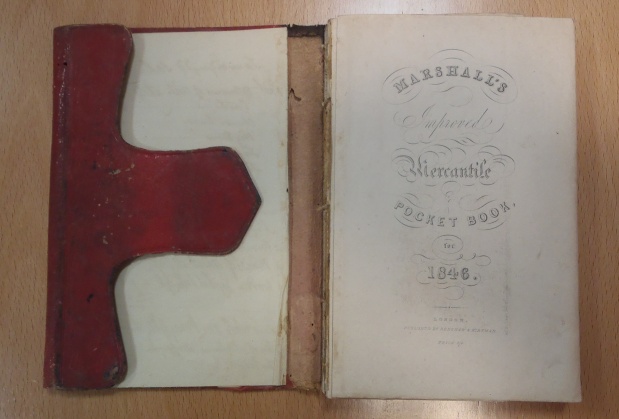
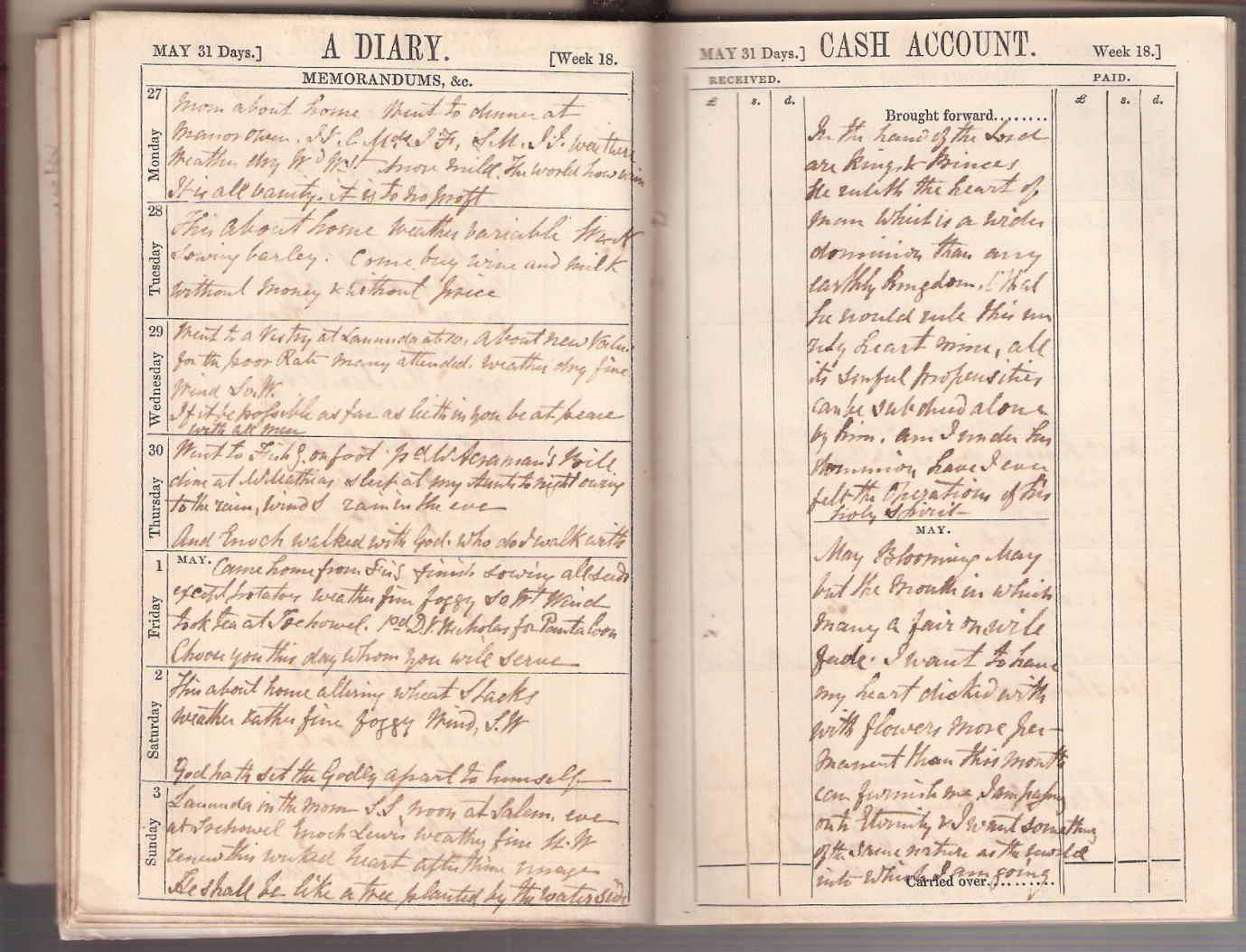
Throughout the diary the biblical quotations and religious writings form the majority of the entries. The selection above is typical – the daily entries recording life on the farm with a biblical quotation closing the day and a longer more personal piece of spiritual writing, (on the accounts page) marking the end of the week.
The chapel attendance on this page indicates that John went to ‘Lanwnda [sic] in the morn,. noon at Salem, eve at Trehowel’ with the verse being ‘He shall be like a tree planted by the waterside’.
The Chapels
The link between the James family and Salem Chapel has been indicated above where the family graves are shown as they are in 2013. More information on the chapel(s) at Trenewydd has been provided by members of the Dyfed Family History Society.
Between 1801 and 1851 it is estimated that an independent chapel was completed every 8 days in Wales (Davies 1992) and three generations of the James family at Trenewydd contributed to this.
In the early days of the Methodists a certificate was needed for a Congregation to meet for religious worship. David Williams, farmer of Velindre, applied to the Clerk of the Peace on the 1st of October 1812 for the registration of Velindre and Trehowel and also a small building opposite the farm at Trenewydd. At this time William James (1760 – 1845) was farming at Trenewydd and it was on his land that the new chapel – Ty Wesley, named after John Wesley, was built.
The first Chapel - Ty Wesley
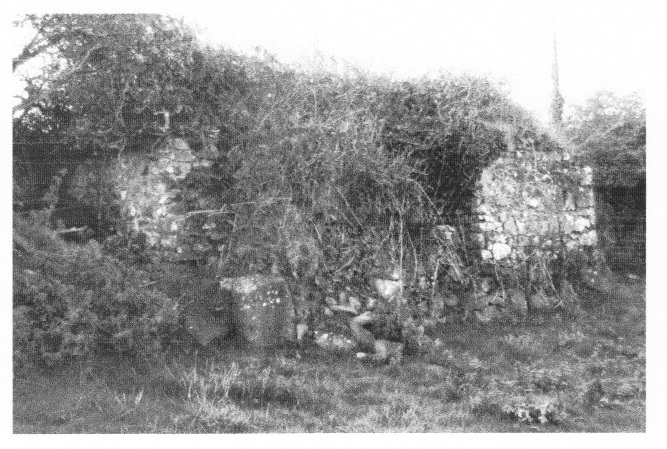
This photograph shows the remains of Ty-Wesley in the grounds of Trenewydd.
(With thanks to Bryan & Carla Stevens, the owners of Salem Cottage.)
By the later 1830’s so many people were attending Ty Wesley that it was decided to build a larger chapel and by 1840 Salem was built on Trenewydd land at a cost of £200. The James’ paid the whole of this as well as contributing to Rhos y Caerau and Fishguard chapels. According to The History of Welsh Independent Churches (1871) it was ‘a handsome chapel with a dwelling house, stable and cemetery with it.’
Several diary entries refer to Salem and John’s diary frequently refers to ‘eve at Salem’ where regular Sunday Schools and prayer meetings took place on Sunday evenings.
An important entry for February 9th (1846) states ‘paid this morn to W Davies &c (etc) the legacy of £100 which my father left to Salem’ and also for November 2nd ‘Today Matty Carlem bach moved to house at Salem’.
By 1845 both William James and his wife Dorothy had been buried at Rhos y Caerau chapel with a memorial to them placed in Salem, (see pictures above)
In July 1847 William James’ son John (the diary writer) married David Williams’ daughter Jane linking the two families further.
Salem Chapel
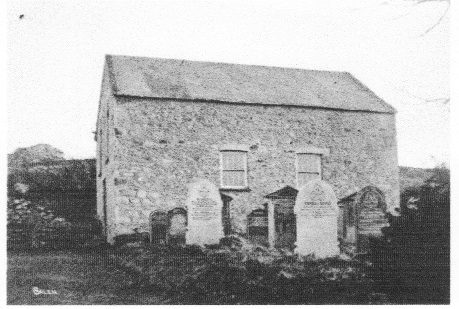
John and Jane’s eldest son William James continued the family connection with Rhos y Caerau as a Deacon and in his will he left Salem Chapel to the Independent Denominations for “one thousand less one years.”
Salem finally became a branch of Rhos y Caerau. The chapel closed in the middle of the twentieth century and was deemed unsafe in 1965 when the roof was removed and the walls lowered. The undergrowth took over until the site was made visible again by the current owners of Salem Cottage, Bryan and Carla Stevens.
(With thanks to Gerwyn Williams and Rosemary Bevan– members Dyfed FHS, DFHS Journal Vol 9, Aug and Vol 10 Dec 2010.)
The entrance to the graveyard with Salem chapel beyond
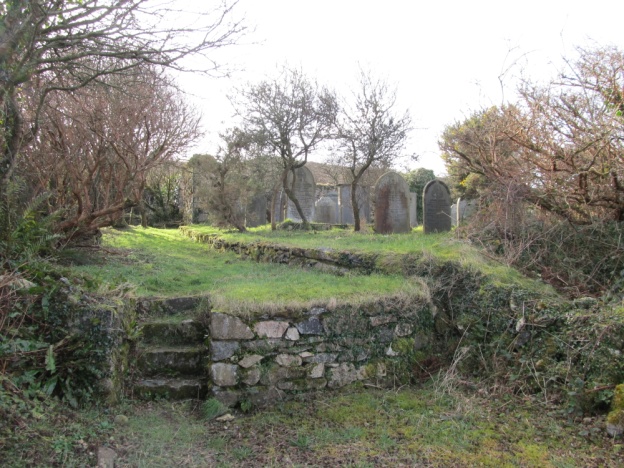
Salem Chapel and Graveyard 2013
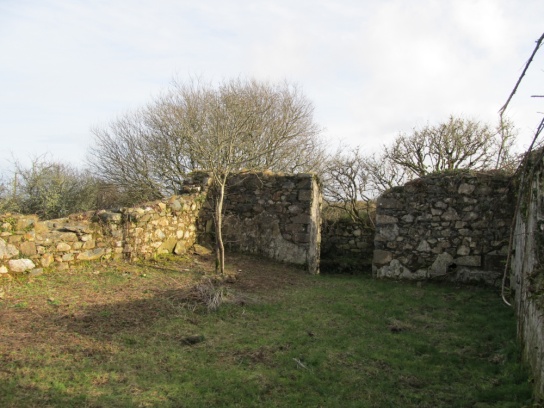
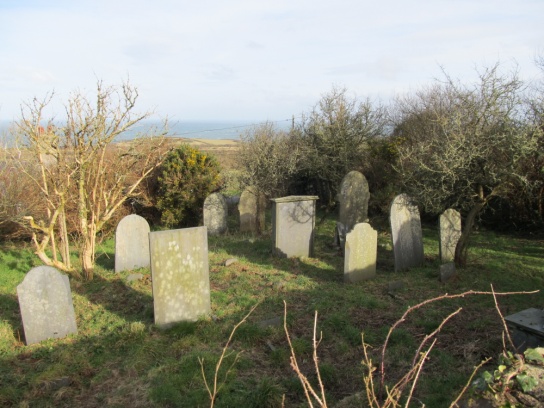
Many thanks are due to:
Hedydd Hughes
The Dyfed Family History Society
Cerys Jones (Institute of Geography and Earth Sciences) Aberystwyth University Pembrokeshire Archives, part of Pembrokeshire County Council
Duncan Brown (Llên Natur – Gwefan naturiaethwyr a phobl Cymru)
Chris Simpkins
June 2013